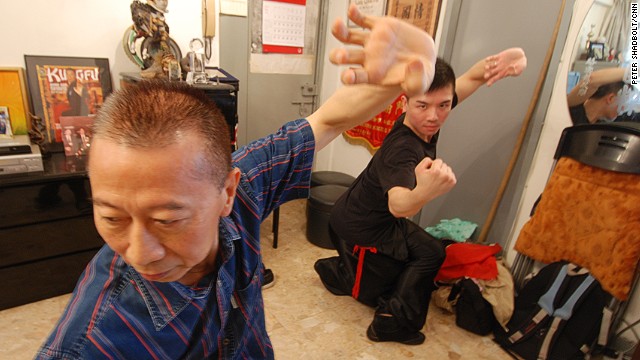English-language manual helps the fight back for Hong Kong kung fu
May 21, 2013 -- Updated 0346 GMT (1146 HKT)

Lam Chun-fai Sifu with his son Oscar display one of the Hung Kuen kung fu stances
But ask Lam Chun-fai Sifu
-- the 73-year-old practitioner of the 300-year-old kung fu style known
as Hung Kuen -- and he will tell you that making the martial art
accessible to foreigners is the only way to save it from extinction.
The son of a student to
Wong Fei Hung, one of the legends of the fighting style and the subject
of countless films, Lam Sifu (sifu is a Cantonese term that means
'master') says the fighting art may be growing fast overseas, but
struggles in the region where it was born.
To counter the decline,
he has co-authored the world's first English-language manual on the
ancient kung fu style that he has taught for 60 years and has been his
family's trademark for more than three generations.
Called Hung Kuen
Fundamentals: Fok Fu Kuen, the manual outlines scores of moves and
stances that were hitherto only taught and transmitted orally.
While there are dozens of
fighting styles in kung fu (the northern styles represented by fast,
high kicks and rapid, fluid movements), Hung Kuen is a southern Chinese
fighting art characterised by strong stances and fast footwork. One
practitioner famously destroyed the bamboo planks in a demonstration
platform simply by shifting his feet in the 'hard stances' of Hung Kuen.
Lam Sifu, meanwhile,
teaches a steady stream of foreigners the ancient fighting art in the
cramped living room of his tiny apartment on the 7th floor of a tenement
block in Hong Kong's North Point.
In terms of Hong Kong
kung fu, it's about as traditional as it gets, right down to the name
'Di Dat Clinic' which translates as 'Hit Fall Clinic'; a name unchanged
from the days when kung fu masters, so used to treating the training
accidents of their students, were the first stop for neighborhood trauma
injuries and broken bones.
Using a spear against his
sword-wielding son Oscar, Lam Sifu is a blur of threshing weapons amid
the armchairs, ornaments and computer printers in his urban home.
"Training in a small
area like this is very good for control," he says in a space so cramped
it looks like two men having a knife fight in a telephone booth. For his
long-standing foreign students -- Hung Kuen teachers from Italy, the
Czech Republic and Germany -- the turn of fighting speed still draws a
gasp of admiration.
"Many students in Italy
like traditional kung fu and especially this style which is the origin
of the martial art," said Massimo Iannaccone, who runs an academy in
Rome but perfects the art in Lam Sifu's living room on trips to Hong
Kong.
Pavel Adamek, who
teaches Hung Kuen in Prague, Czech Republic, says his students are drawn
as much by the Eastern philosophy associated with the martial art as
they are by learning a fighting style.
"It's very popular in
the Czech Republic -- people there are really looking for something more
than fighting arts. They want to train their bodies and their minds --
this style is really very good for that," he said.
While there may be more
dedicated practitioners overseas than in Hong Kong, Lam Sifu's co-author
Hing Chao, who also studies the Hung Kuen style, said that the form
remains a potent cultural symbol in Hong Kong.
"It's rooted in a very
specific Hong Kong identity as well," Hing said. Both he and Lam Sifu
believe the style is so important as a cultural symbol, the government
should recognize it as part of Hong Kong's intangible cultural heritage.
Training in a small area like this is very good for control
Lam Chun-fai Sifu
Lam Chun-fai Sifu
Hing, who has studied
the interaction between the media, entertainment and the martial arts,
says that Hollywood sometimes gives a lopsided view of Chinese martial
arts, focusing on various personalities such as Ip Man, Bruce Lee's
famous teacher, to the exclusion of all other equally famous teachers
and styles.
Despite this, he says its popularization in film sometimes unconsciously transmits positive aspects of kung fu culture.
"Besides the fighting,
one of the reasons that Bruce Lee has been such a global celebrity until
to today is because a lot of messages strike a chord and resonate among
the marginalized," Hing says.
"Why would, for
instance, a Black African community in the U.S. look on Bruce Lee as a
hero? Because embedded in these films are messages of righteousness. Of
someone who is disadvantaged but through dedication to kung fu can
become empowered and through his own empowerment help the rest of the
community.
"This is very positive
and I would say the Bruce Lee path represents one of the best
interactions between film and martial arts -- it's something we don't
often see these days."
While foreigners may be
beating a path to the kung fu clinic's door, local interest in Hong Kong
is only just gaining ground after a long hiatus.
Lam Sifu says modern
distractions like videogames are sapping young people of the ability to
focus on demanding martial art forms like Hung Kuen which can require
learning as many as 300 movements in a single set.
"These days pupils can't stand any hardship. They say practicing is tiring and they give up easily," he says.
No comments:
Post a Comment